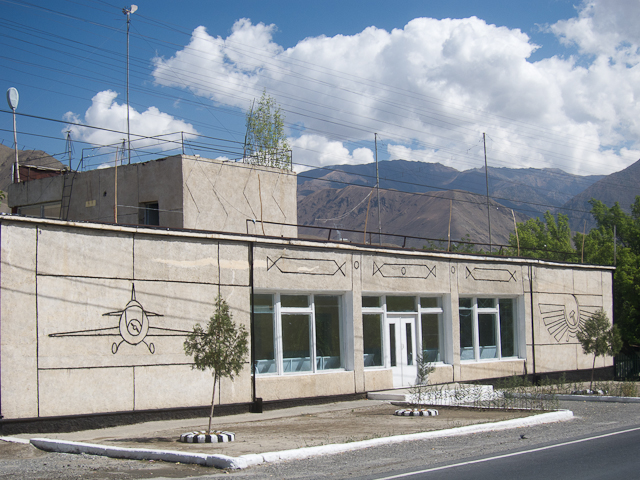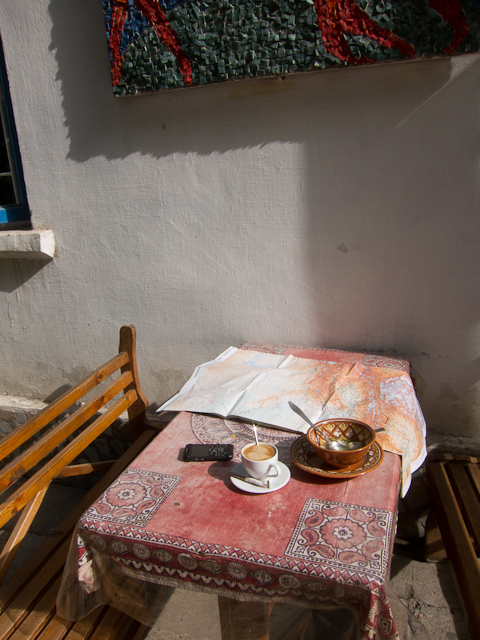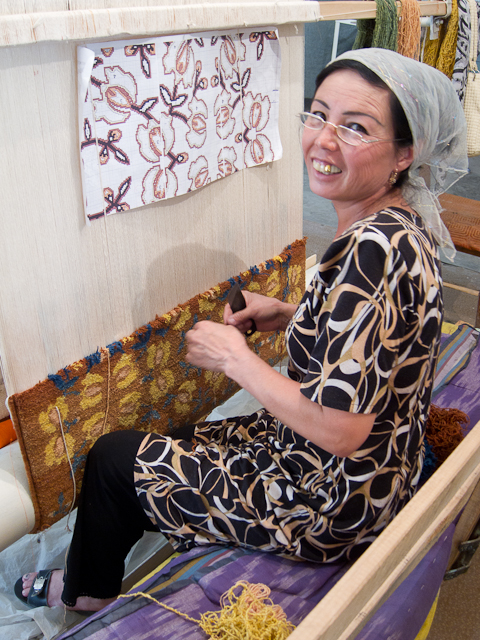One last comment regarding history and it’s hold/motivation on people. At the Sultan Ali concert in Bukhara part of the light show displayed camel caravans and the crowd LOVED it. And these people KNOW that dromedaries (one humper) and bactrians (two humper) to a lesser extent are rarely smart, often in a poor mood, and stubborn. The Soviets “reformed” these nomads and now . . . they’re (largely) just like us, though not as wealthy (or free). But the romantic appeal of the old days (VERY old days) is strong. Maybe like the old West or being on a farm appealed to many Americans.
But it’s a FACT that those caravans moved between cities which were largely or entirely crafted from Tajik peoples. (In fact, several times there’s been a petition to make Kiva, Bukhara and Samarkand part of Tajikistan (the current placement within “Uzbekistan” is the work of a historic charmer and do-gooder, Joseph Stalin.) That fact is completely lost on most Uzbek ethnics. Uzbeks speak a Turkic-based language and Tajiks speak a Farsi-based (“persian” – from modern Iran) language.
The Tajik’s kind of remind me of Nepal, and most importantly, the Kathmandu Valley’s Newari’s. The Newari’s are NOT in control of Nepal nor the Kathandu Valley and never really have been. But they CREATED what is popularly known as Kathmandu. They were the craftsmen and architects and designers of an enormous amount of far-reaching work that we can see any, and everyday. (For instance, the tiled roof on Chinese/Korean/Japanese houses and temples – originated in Nepal.) Their woodworking skills have been considered amongst the very best, ever, for some time. Newari craftsmen did much of the fine work at Thupchen Monastery (perhaps the Sistine Chapel of Tibetan Buddhism).
So with the KTM’s electrical issues seemingly solved I was “free” to visit a few sights and prepare for the next part of the trip. The plan was to pick up my Passport and new KZ Visa at the Embassy at 5 on Wednesday and then drive toward Fergana and enjoy some ultra-ethnic experience and learn about the production and processing of silk in the world’s 3rd largest producer of silk, Uzbekistan.
Rustam rode me out of town and even directed me to a shortcut. It meant that I only made it to Kokand, even then quite late, but I would be within 75km (45 miles) of Fergana in the AM. The place I found in Kokand had NO electricity. It was new, festooned with all sorts of blingey chinese crap with names like “Delta Quartz” and “Finest Fashion”. It had a nice veneer . . .
Unfortunately, I did NOT have my new KZ Visa. For whatever reason, the approval had not come to the Embassy and I was informed that I would have to “wait”. There were several others present who also did not get their Visa as expected, including a Spanish couple who’d been waiting 10 days after being promised 5 days.
Kokand was another of the Glorious Maximum Leader’s “Potemkin Towns”. It had HUGE shopping areas, some houses fit for a Glorious Maximum Leader and a park lighting array surrounding the old medressa worthy of Times Square. I really think alot of the world has followed the US right off the cliff with a manufactured (ie, created/manipulated) housing boom. The attractiveness is too much for any pol or leader. Lots of jobs, instant “renewal”, a feel-good unavailable without controlled substances . . . everything until the bill finally comes due.
What is one to make of a country which has a glimmering cookie-cutter template for it’s college structures that are buildings which do NOT indulge questioning students that have air-conditioning but no running water . . .
So I got up very early, wanting to see the earliest sign of life in the Fergana bazaar from my powerless “hotel”. The drive was very pleasant – clean air, light traffic and lots of good, rural, agricultural scenery and scents.
At Fergana I stopped at a recommended place and . . . it was so cool I didn’t know what to do. They had illy coffee. (It’s been 6 weeks since I’ve had real coffee . . .) They also had a bag of Starbucks which cracked me up. (Starbucks summons Abe Lincoln’s wisdom “If that’s the coffee, I’ll have the tea, and if that’s the tea, I’ll have the coffee.”) Anyway, a bowl of russian meat ravioli soup and 3 double espresso’s later (they were $1 each), I went to the Fergana bazaar.
The bazaar was interesting enough but apparently no match for the Orange Duckling. Within seconds there was a crowd of surrounding me. The response to “America” were much more emphatic surprise than normal. (I’ve met just two Americans on this entire trip, they were fresh out of school and traveling together. Since 9/11 we’ve become VERY rare things.) I quickly moved on to have a look around.
Fergana is an Uzbek village in a conservative Tajik region. Almost immediately a man chased after me. When he finally caught me he gestured great concern for the KTM, my documents, etc. He seemed certain that the bazaar was full of thieves. He didn’t appear to have any official standing but he carried himself quite seriously. I forced him to take a long path back to the bike so I could see more and when we returned to 50 or so men he pointed with almost a “I told you . . . ” look.
So I rode on to Margolin . . . to the silk factory where almost no electricity is used, no chemical dyes and where one can buy a meter (40″) square of silk for about $15. There was also a bazaar to see since it was Thursday, the Kumtepa.
Neither disappointed. I fell in with a Spanish tour group and we were shown the whole tale from worms to looms. The Kumtepa was truly something special. Again the Duckling drew a huge crowd but this time there was considerable difference. This was more of the VERY conservative Fergana valley. There was very little western clothing. Almost no baseball caps. Lots of white beards and women covered. The part selling chinese junk was . . . less interesting. But the bulk sold produce, bread, meats & fish (fresh and prepared) and . . . lots of tea. There were no other europeans – at all. And the sense that there wasn’t a West was the strongest I’ve felt in more than 20 years. It was fantastic.
So from an early start to a fantastic indulgence the day had worn on a bit too fast. I scrambled to exit Fergana and head for Khojand/Khunjand/Hojand and exit Tajikistan on the way to Dushanbe. (The transliteration of words from Tajik/Uzbek/Russianized Cyrillic is a never ending amusement. For instance, Kiva/Khiva/Xiva can be pronounced ‘kee-va’, ‘kee-wah’, and ‘she-va’. From Urgench to Kiva it’s 30 km (20 miles) and I saw just three signs indicating direction – ALL different spellings !)
There is at least one thing worse than a huge queue at a border crossing. No queue. When you are that one, mischief ensues. Consider many developing country border crossings as “tax collection centers” with a fluid rate. They must process the queue and so while fishing “throw the little ones back and keep the big ones”. According to the Uzbek official who greeted me no foreigner had been through in several months. At the gate it didn’t look like ANYONE had been through in months. When I first drove up it seemed abandoned.
The Uzbek side was formality though hardly a process. Somewhat polite and somewhat gruff with even basic information requiring repeated entering/responding even if it already existed on a previously stamped Uzbek form.

But the Tajik side was another story. From the initial moment I was asked for money, just to be “let in” the gate to the officials kiosk. At least 7 officials asked for money, two “official” baksheesh. The only thing that saved me was my lack of Russian, alot of experience crossing crappy borders, and an insistence on behaving a bit madly (ultra-eccentric). When they took my photo at the last un-official inspection (after brandishing a sub-machine gun) I posed with the Hawaiian good-luck symbol pointed to the earth for them. Awful. Makes you feel dirty.
That transitioned to a nearly abandoned town along the giant Kairukum reservoir that clearly hadn’t seen any municipal investment in years if not decades. Ironically enough, there was a ‘bankomat’ (ATM) that dispensed Tajik Som or USD and the Tajik men there were very friendly and warm.
A 90-km ride along the reservoir to Khunjand was in the cards and no further the Tajik border extortion had failed but had exhausted the sun and now rain was coming. Surely it was snowing in the mountains to the south. While Tajikistan’s glaciers continue to shrink rapidly the Kairukum reservoir threatens to collapse due to an earthquake with the possibility of sending waters of destruction far into Uzbekistan, possibly as far as the Aral sea.
Tajikistan kept provoking memories of Romania though I’m not sure why, exactly. Yes, the women are generally wearing headscarves and not as colorful as Uzbek women. Yes, it’s incredibly poor with many people living in mud-walled, single room houses less than 15 meters (150′) square. Yes, there is little electric lighting in the towns which contributes to a “dark” atmosphere. Tajiks are classically of Persian descent and so you see almost no epicanthic folds . . . unlike Uzbekistan. But there was, early on, a sense of darkness or foreboding or just having been abandoned in Tajikistan – like the civil war had caused a giant brain and genetic drain and what was left was what couldn’t escape.
The road from Khojand to Dushanbe was a marvel. Wide, smooth, with a paved shoulder . . . it was the best road I’d been on since Austria and required less than laser focus to ride, which was a nice relief. No sudden giant potholes, walls of sand, gusting sidewinds (though quite a headwind, but steady), roaming cattle, mad dogs, crazy children. Just a relatively high-speed jaunt in the country. On one side there was green farmland from the reservoir’s irrigation, on the other side sun-baked dust to brown high hills with amazing canyons etched by water and wind.

It's easy to find Soviet legacy, it's less easy to find it so laughable - airport terminal building.
It was just 300km (185 miles) to Dushanbe and the first 130km were very pleasant. When the road “ended” it turned into a very rough track headed up steeply toward the mountains at 8000′. The chinese are constructing a tunnel to bypass this Russian track using almost exclusively Chinese workers but it’s some time from being completed. The pass is at 11,300’/3380 meters. It was hard to miss the evidence of fresh snow – it was cold, snow was everywhere, and the sun was making lots of water spill down the track to the pass.
So up I went chasing a rag-tag caravan of Mercedes sedans, SUVs, small vans and . . . fairly large trucks. They moved at between 15-25 kph (10-15mph). I could do 50-100% faster and did.
At about 10,000′ snow, ice and heavy mud began to cover the track depending upon how much sun was on it. At the top, the temperature quickly became warmer (southern facing) and the downside was almost plain fun. At the bottom I stopped at a chaikana for food (shashlik and shorba/soup and tea.
The ride to Dushanbe provided more great scenery and would have been very pleasant if not for the through the Anzo Tunnel. It’s length is variously reported as 14km/22km. My measurement showed just short of 6km.
Six kilometers (3.5 miles) of unlit, un-vented narrow tunnel. The floor is covered in water, sometimes up to 10″ deep and potholes that even the large trucks try to avoid. I’m sure my risk of lung cancer increased manifestly after that 45 minute ordeal. The headache from the fumes was awful. I’d heard about this tunnel and had determined that the old road over the pass was my route. But due to the snow I was virtually forbidden from trying.
So into Dushanbe and now a spirited jaunt across really bad roads in the Panj River valley along the Afghan border and parts of the Pamir Highway to Osh in Kyrgyzstan.
My internet access is likely to utterly collapse for as much as the next 10 days and even SPOT readings might seem “irregular” – it doesn’t work that well in the mountains in general and poorly in steep valleys.
The next 1500km/1000 miles may be quite quiet on this channel.
My only comment on the actual economic crisis now unfolding (2008 was just the warning shot – giving countries and people time to adjust to the coming tsunami – few did . . .). Well, the exchange rate for Euros vs USD to local currency has been sliding hard since I entered KZ. In Dushanbe, the exchange rate for Euro/USD is about 1.2. Euro – BAIL !



















4 Responses to When nobody in line is NOT a good thing . . .